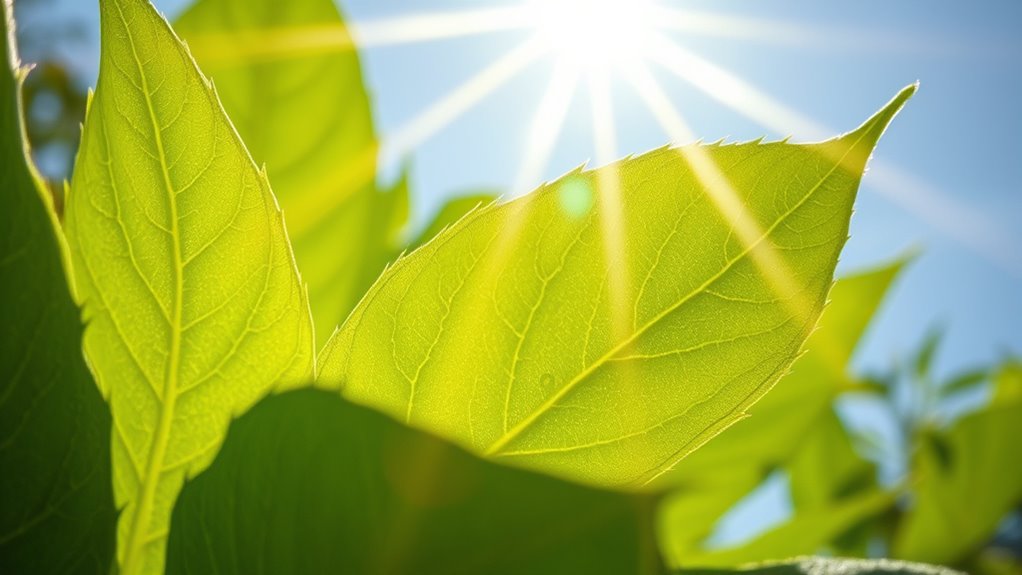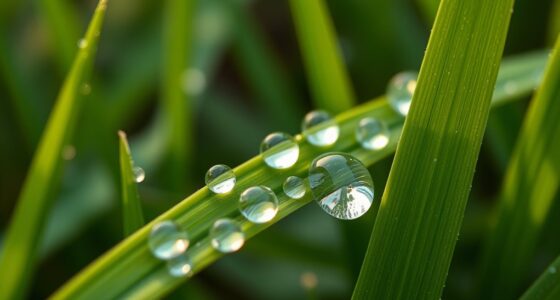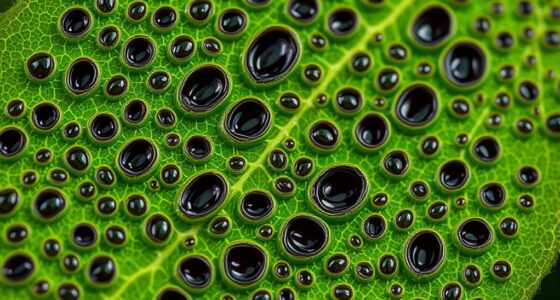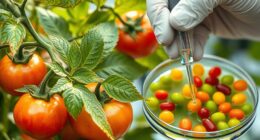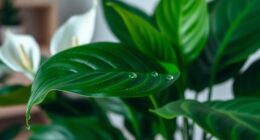Strong summer sunlight exposes your plants to higher levels of UV-B rays, which can damage their DNA by causing thymine dimers that block essential processes like growth and development. To combat this, plants produce protective compounds such as flavonoids and develop structural defenses like thicker leaves, which act as natural sunscreen. Their ability to repair DNA damage efficiently determines how well they withstand intense UV-B exposure. If you want to discover how plants balance these defenses, keep exploring.
Key Takeaways
- Strong summer UV-B rays penetrate plant tissues, causing DNA damage such as thymine dimers.
- Plants activate repair systems like photoreactivation and nucleotide excision repair to fix UV-induced DNA lesions.
- Excessive UV-B exposure can overwhelm repair mechanisms, leading to DNA damage accumulation and stress responses.
- Plants produce protective compounds like flavonoids and develop structural changes to absorb or block UV-B rays.
- Efficient DNA repair and protective adaptations enable plants to survive and maintain growth under intense summer sunlight.
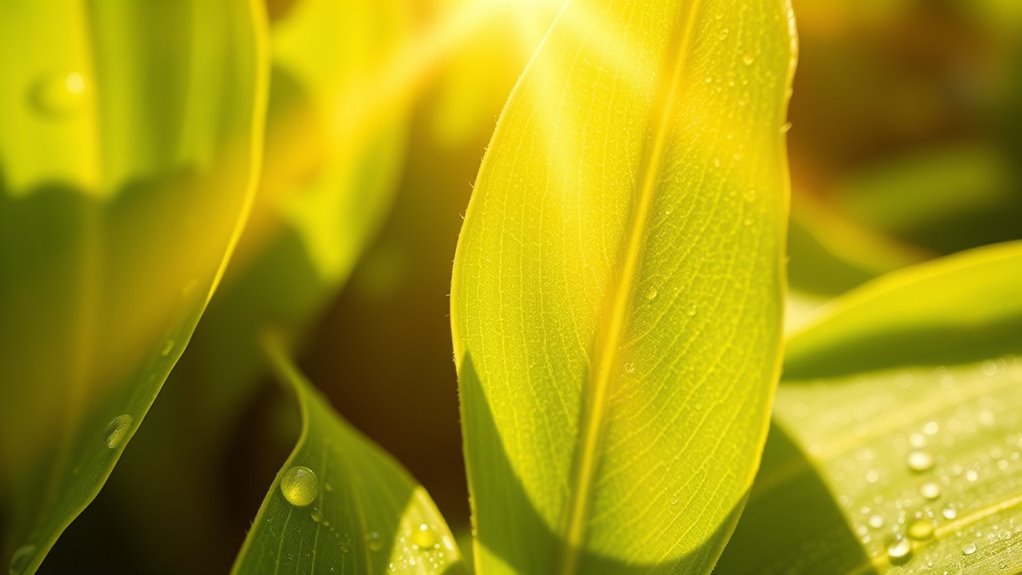
UV-B exposure refers to the ultraviolet radiation from the sun that reaches Earth’s surface and interacts with your skin. While most people think about its effects on skin, UV-B rays also impact plants in significant ways. When sunlight hits plant leaves, UV-B can penetrate the tissues and cause damage to their cellular components, especially their DNA. This damage, known as UV damage, results from the formation of thymine dimers—abnormal bonds between adjacent thymine bases in the DNA strand. If left unrepaired, this damage can interfere with essential cellular processes like replication and transcription, ultimately impairing plant growth and development.
Fortunately, plants have evolved mechanisms to counteract UV damage through efficient DNA repair systems. When your plant detects DNA lesions, it activates repair pathways such as photoreactivation and nucleotide excision repair. Photoreactivation involves enzymes called photolyases, which absorb blue light and use that energy to cleave thymine dimers, restoring the DNA to its original state. Nucleotide excision repair, on the other hand, involves a series of enzymes that recognize distorted DNA regions, excise the damaged section, and fill in the gap with correct nucleotides. These repair processes are essential because they help maintain the integrity of the plant’s genetic information, allowing it to continue normal growth despite UV-B stress.
However, the effectiveness of DNA repair can vary depending on the intensity and duration of UV-B exposure. During strong summer sunlight, the increased UV-B radiation can overwhelm a plant’s natural repair mechanisms if it isn’t adequately protected. This can lead to accumulation of unrepaired DNA damage, which may trigger stress responses, inhibit photosynthesis, or even cause cell death. To mitigate these effects, many plants develop protective strategies such as producing UV-absorbing compounds like flavonoids and phenolic acids. These compounds act as natural sunscreens, filtering out harmful UV-B rays before they reach sensitive DNA regions. Additionally, plants can alter their leaf structure, such as increasing leaf thickness or waxiness, to reduce UV penetration. Furthermore, some plants can activate DNA repair mechanisms more rapidly when exposed to increased UV-B, enhancing their resilience against damage.
Frequently Asked Questions
How Do Plants Repair UV-B Induced DNA Damage?
When UV-B causes DNA damage in plants, you rely on DNA repair through enzymatic mechanisms. These enzymes recognize damaged DNA sites and cut out the affected sections. Then, they synthesize new DNA to replace the damaged parts, restoring genetic integrity. This repair process helps your plants survive harsh sunlight, maintain healthy growth, and adapt to UV-B stress, ensuring their DNA remains functional despite environmental challenges.
Can UV-B Exposure Increase Plant Resistance to Pests?
You might think UV-B exposure is just about sunburns, but it actually boosts your plant’s pest deterrence and immune response. When exposed to UV-B, plants produce more defensive chemicals, making pests think twice before munching. This natural defense mechanism strengthens, turning your plants into nearly invincible warriors against pests. So, a little extra sunlight can make your plants tougher, healthier, and less vulnerable—like giving them superpowers!
What Are the Long-Term Effects of UV-B on Plant Growth?
You might notice that long-term UV-B exposure causes growth suppression in plants, making them smaller or less vigorous over time. It can also lead to flowering delay, which affects reproduction and seed production. These effects happen because UV-B damages plant DNA and interferes with normal development. While some plants adapt with increased defense mechanisms, prolonged exposure generally hampers overall growth and flowering, impacting plant health and productivity.
Do Different Plant Species React Differently to UV-B Radiation?
You might think all plants respond the same way to UV-B radiation, but species variability shows otherwise. Different plant species react uniquely, thanks to their adaptive strategies shaped by evolution. Some develop thicker cuticles or produce more UV-absorbing compounds, while others may be more sensitive. Recognizing this diversity helps you understand how plants survive in varying sunlight conditions and emphasizes the importance of species-specific research for conservation and agriculture.
How Does UV-B Exposure Influence Plant Secondary Metabolite Production?
You see, UV-B exposure activates secondary metabolite pathways through UV B signaling, prompting plants to produce protective compounds. When exposed to UV-B, your plants ramp up the synthesis of flavonoids, phenolics, and other secondary metabolites that shield against UV damage. This process helps them adapt and survive. So, increased UV-B triggers these pathways, boosting secondary metabolite production as part of their defense mechanism.
Conclusion
So, as you bask in summer’s bright sunlight, remember that your plants are busy battling UV-B’s fierce assault on their DNA. Ironically, while you enjoy the warmth, they’re developing defenses that might just make them stronger—if only you paid more attention. In the end, it’s a reminder that nature’s resilience often thrives in the face of adversity, even if you’d rather just soak up the sun without a second thought.

